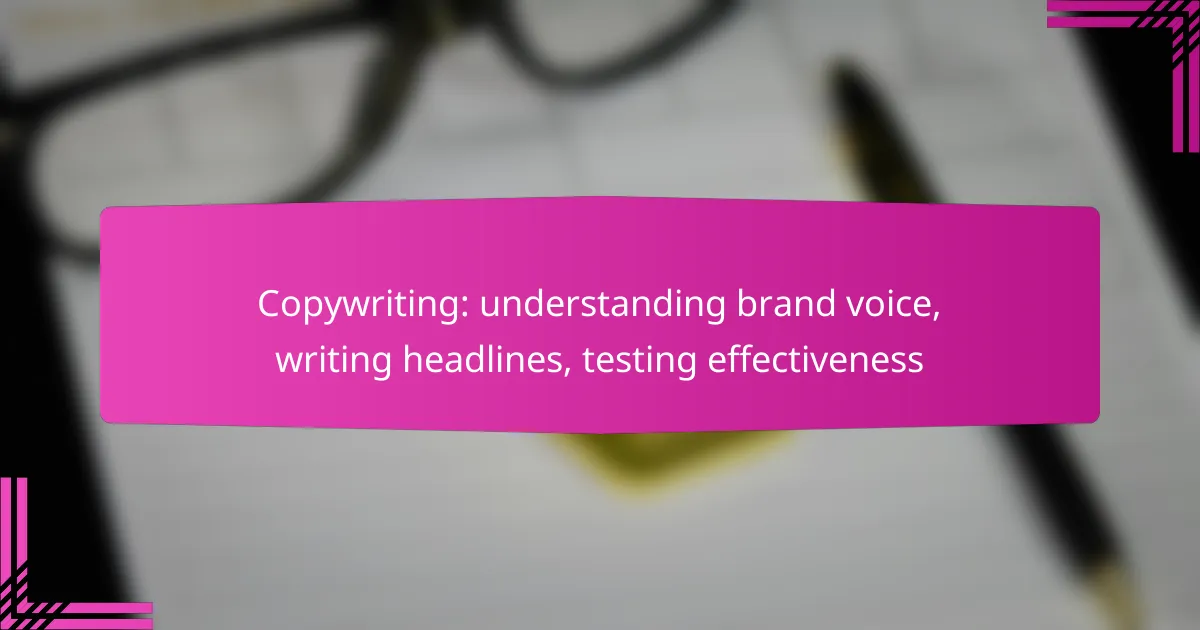Copywriting is an essential skill that involves crafting a brand voice that aligns with your identity and connects with your audience. By mastering effective headline writing techniques and rigorously testing your content’s effectiveness, you can enhance engagement and drive desired actions. Understanding these elements will empower you to create compelling copy that stands out in a crowded marketplace.

How to develop a brand voice in copywriting?
Developing a brand voice in copywriting involves creating a consistent tone and style that reflects your brand’s identity and resonates with your audience. This process requires understanding who your audience is, analyzing competitors, and ensuring your messaging remains coherent across all platforms.
Identify target audience
Identifying your target audience is crucial for developing a brand voice that speaks directly to them. Consider demographics such as age, gender, location, and interests. Conduct surveys or use analytics tools to gather insights about their preferences and behaviors.
Once you have a clear picture of your audience, tailor your language, tone, and messaging to align with their expectations. For example, a youthful audience may respond better to casual language, while a professional audience may prefer a more formal tone.
Analyze competitor voices
Analyzing competitor voices helps you understand the landscape and identify gaps in the market. Review their marketing materials, social media posts, and website content to see how they communicate with their audience. Take note of their tone, style, and messaging strategies.
By understanding what works for your competitors, you can differentiate your brand voice. Aim for a unique approach that highlights your brand’s values and personality, making it stand out in a crowded marketplace.
Create a voice chart
A voice chart is a practical tool that outlines your brand’s voice attributes. Include key characteristics such as tone (friendly, authoritative, playful), style (formal, conversational), and vocabulary (technical, everyday language). This chart serves as a reference for anyone creating content for your brand.
To create an effective voice chart, involve team members from different departments to ensure a comprehensive perspective. Regularly update the chart as your brand evolves or as market conditions change.
Test voice consistency
Testing voice consistency involves reviewing your content across various channels to ensure it aligns with your established brand voice. Conduct regular audits of your website, social media, and marketing materials to identify any discrepancies.
Gather feedback from your audience through surveys or social media interactions to gauge their perception of your brand voice. Consistency fosters trust and recognition, so make adjustments as needed to maintain a cohesive identity.

What are effective headline writing techniques?
Effective headline writing techniques grab attention and encourage readers to engage with the content. Key strategies include using power words, incorporating numbers, asking questions, and focusing on benefits to create compelling headlines.
Use power words
Power words evoke strong emotions and can significantly enhance the appeal of your headlines. Words like “ultimate,” “exclusive,” and “proven” create a sense of urgency and importance, prompting readers to click. Aim to include one or two power words in your headlines to maximize impact.
Consider testing different power words to see which resonate best with your audience. For example, “unlock” may perform better than “access” in a headline about a new feature. Use A/B testing to refine your choices.
Incorporate numbers and lists
Using numbers in headlines can make your content appear more digestible and credible. Headlines like “5 Tips for Effective Copywriting” or “Top 10 Strategies to Boost Engagement” clearly indicate what readers can expect. Numbers provide a quick overview and can enhance shareability on social media.
Lists are particularly effective because they promise structured information. Aim for odd numbers, as they often attract more attention. For instance, “7 Reasons Why Your Brand Needs a Voice” can be more enticing than “6 Reasons.”
Ask questions
Questions in headlines engage readers by prompting them to think about their own experiences or needs. A headline like “Are You Making These Common Copywriting Mistakes?” invites curiosity and encourages clicks. This technique can create a personal connection with the audience.
When crafting question-based headlines, ensure they address a specific pain point or interest relevant to your target audience. This approach not only attracts attention but also sets the stage for valuable content that answers their queries.
Focus on benefits
Highlighting benefits in your headlines informs readers of the value they will gain from your content. Instead of simply stating what the article is about, emphasize how it can help them. For example, “Learn to Write Headlines That Convert” suggests a clear advantage for the reader.
To effectively focus on benefits, think from the reader’s perspective. What problems will your content solve? What knowledge or skills will they gain? Crafting headlines that answer these questions can significantly increase engagement and click-through rates.

How to test the effectiveness of copywriting?
Testing the effectiveness of copywriting involves evaluating how well your content resonates with your audience and drives desired actions. This can be achieved through various methods that provide insights into performance and engagement.
Utilize A/B testing
A/B testing, or split testing, allows you to compare two versions of your copy to see which performs better. Create two variations of a headline or call to action and direct traffic to both, measuring which version leads to more conversions or engagement.
When conducting A/B tests, ensure you have a clear hypothesis and a sufficient sample size to yield reliable results. Aim for a testing period that captures typical user behavior, often a few weeks, depending on your traffic volume.
Analyze engagement metrics
Engagement metrics provide quantitative data on how users interact with your copy. Key metrics include click-through rates, time spent on page, and conversion rates, which reveal how effectively your copy captures attention and encourages action.
Use tools like Google Analytics to track these metrics. Regularly review performance to identify trends and make data-driven adjustments. For instance, a low click-through rate may indicate that your headline needs refinement.
Gather audience feedback
Direct feedback from your audience can offer valuable insights into the effectiveness of your copy. Conduct surveys, interviews, or focus groups to understand how your messaging resonates and what improvements can be made.
Encourage feedback through various channels, such as social media or email campaigns. Consider offering incentives for participation, which can increase response rates and provide a broader perspective on your copy’s impact.

What criteria should be considered for copywriting success?
Successful copywriting hinges on several key criteria, including clarity, emotional resonance, and effective calls to action. These elements work together to engage the audience and drive desired responses.
Clarity and conciseness
Clarity and conciseness are essential for effective copywriting. Clear messaging ensures that the audience quickly understands the intent, while concise language keeps their attention. Aim for straightforward sentences and avoid jargon unless it’s familiar to your target audience.
To achieve clarity, use active voice and direct language. For instance, instead of saying “The product can be purchased at a discount,” say “Buy the product now for a discount.” This approach not only clarifies the message but also makes it more compelling.
Emotional resonance
Emotional resonance connects with the audience on a personal level, making your copy more impactful. Understanding your audience’s values, desires, and pain points allows you to craft messages that evoke feelings, whether it’s joy, fear, or urgency.
For example, a campaign for a charity might highlight personal stories of those helped by donations, creating a sense of empathy and encouraging contributions. Use vivid language and relatable scenarios to strengthen this emotional connection.
Call-to-action effectiveness
An effective call to action (CTA) guides the audience toward the next step you want them to take. A strong CTA is clear, compelling, and creates a sense of urgency. Phrases like “Sign up today” or “Get your free trial now” prompt immediate action.
To enhance CTA effectiveness, consider placement and design. Make sure your CTA stands out visually and is easy to find. Testing different phrases and formats can help identify what resonates best with your audience, leading to higher conversion rates.

How does Australian culture influence copywriting?
Australian culture significantly shapes copywriting by emphasizing authenticity, humor, and local relevance. Understanding these cultural nuances can enhance engagement and resonate with the target audience.
Use local slang and references
Incorporating local slang and references in copywriting can create a sense of familiarity and connection with the Australian audience. Terms like “arvo” for afternoon or “bikkie” for biscuit can make the content feel more relatable.
When using slang, ensure it aligns with the brand voice and the context of the message. Overusing jargon or obscure references may alienate readers rather than engage them. Balance is key.
For example, a casual brand might use phrases like “grab a cold one” to promote beverages, while a more formal brand should opt for clear, straightforward language that still respects local culture.



